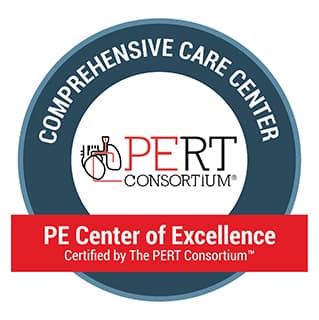Pulmonary Embolism (PE)
What is Pulmonary Embolism?
A pulmonary embolism occurs when a blood clot that is formed in a deep vein of the body (deep vein thrombosis) breaks loose and travels through the vessels to the lungs. The piece of clot lodged in the lung can reduce or completely restrict blood flow in or out of the lung. This condition can be life-threatening if not treated quickly.
At the University of Chicago Medicine, experts from cardiology, cardiac surgery, hematology, pulmonary critical care medicine, radiology and vascular surgery work together to determine what treatment is the best, safest and most effective for each patient.
UChicago Medicine's Pulmonary Embolism Response Team (PERT) is available 24 hours a day to provide consultation and care for these sometimes complex patients.
Pulmonary Embolism Symptoms and Causes
Pulmonary embolism is a serious and life-threatening condition, and being able to identify signs associated with the blockage will help you determine when you need medical assistance. Common PE symptoms include:
- Trouble breathing
- Lightheadedness or dizziness
- Sudden low blood pressure (hypotension)
- Chest pain
- Coughing up blood
- Excessive sweating
- Rapid or irregular heartbeat
Understanding the risks associated with PE is crucial, and typical causes and risks include:
- Smoking
- Sedentary lifestyle
- Having an existing blood clot
- Family history or genetic condition
- Contraceptives or estrogen medication
- Recent surgery or prolonged hospitalization
- Advanced age
If you are experiencing one or more of the above symptoms, contact your physician immediately.
How to Diagnose Pulmonary Embolism
Because the symptoms of PE are also commonly found in other serious conditions, UChicago Medicine experts will do a comprehensive evaluation to determine your exact diagnosis. When you are being examined for possible PE, one or more of the following tests may be necessary.
Dual-energy computed tomography (CT) pulmonary angiography is used to identify pulmonary emboli and determine the amount of lung tissue in jeopardy.
Transthoracic echocardiography (TTE) uses ultrasound to create images of the heart, and will show evidence of heart failure due to blood clots obstructing blood flow in the lungs.
Electrocardiography (ECG) is used to test measure the electrical activity of the heart.
Ventilation-perfusion scanning measures airflow (ventilation) and blood flow (perfusion) in the lungs, and does not require intravenous contrast.
Treating Pulmonary Embolism
UChicago Medicine’s comprehensive pulmonary embolism team (PERT) is a cohesive unit that quickly involves all necessary experts across a wide range of specialties when a patient is diagnosed with a PE. The collaborative nature of our program and our experience with all available techniques for treating PE makes us unique. Together, our team will recommend the best treatment strategy for each individual patient.
Almost all patients will need anticoagulants, or blood thinners, to prevent future blood clots from forming. Combining medication with lifestyle changes (such as wearing compression socks, eating healthier, quitting smoking and exercising) can lower your risk of further PEs.
Known as clot busters, thrombolytic medications work to dissolve a blood clot. Unlike anticoagulants, fibrinolytic therapy is not a pill, but instead is delivered via an IV or through catheterization to deliver the medication directly into the vessel.
As the largest vein in the body, the inferior vena cava (IVC) is critical for maintaining blood flow to the heart and lungs. If clot-busting medication or anticoagulants are not enough to dissolve or decrease the blood clot, or if you cannot take these medications, IVC filters can be implanted to trap and prevent additional blood clots from traveling to the lungs.
For severe, life-threatening PE, the clot may need to be totally removed through pulmonary embolectomy. This procedure can be performed using minimally-invasive catheterization techniques or open surgery, depending on the location and size of the clot.
For patients with cardiovascular collapse due to PE, our cardiologists and surgeons routinely use ECMO to provide full cardiopulmonary support. ECMO uses large cannulae (tubes) to drain blood from the body, provide oxygen to the blood, and pump the blood back into the body. ECMO is available 24 hours a day.
If you have a pulmonary embolism, we recommend you reach out to our our multidisciplinary post-PE clinic. Our unique care team, comprised of cardiologists, pulmonary/critical care experts, and hematologists, will determine the appropriate duration of anticoagulation therapy, screen for genetic causes of blood clots, arrange for removal of IVC filters if no longer needed and screen for chronic thromboembolic pulmonary hypertension (CTEPH).

Comprehensive Center of Excellence
UChicago Medicine's Heart and Vascular Center has been recognized by The PERT Consortium™ as a Comprehensive Center of Excellence for its management of pulmonary embolization. UChicago Medicine is one of only eight programs in the world to receive the distinction based on rigorous accreditation criteria.
Learn moreRequest an Appointment
We are currently experiencing a high volume of inquiries, leading to delayed response times. For faster assistance, please call 1-888-824-0200 to schedule your appointment.
If you have symptoms of an urgent nature, please call your doctor or go to the emergency room immediately.
* Indicates required field


